中考英语专题讲义:句子类型(带答案)
- 格式:doc
- 大小:192.50 KB
- 文档页数:16
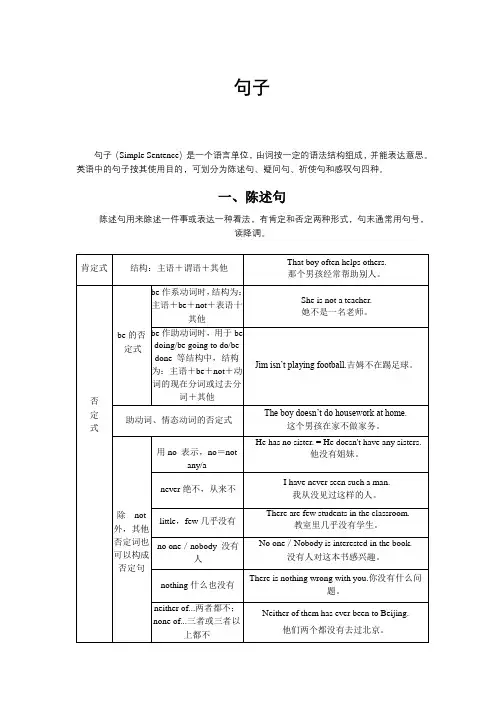
句子句子(Simple Sentence)是一个语言单位,由词按一定的语法结构组成,并能表达意思。
英语中的句子按其使用目的,可划分为陈述句、疑问句、祈使句和感叹句四种。
一、陈述句陈述句用来除述一件事或表达一种看法,有肯定和否定两种形式,句末通常用句号,读降调。
肯定式结构:主语+谓语+其他That boy often helps others. 那个男孩经常帮助别人。
否定式be的否定式be作系动词时,结构为:主语+be+not+表语十其他She is not a teacher.她不是一名老师。
be作助动词时,用于bedoing/be going to do/bedone 等结构中,结构为:主语+be+not+动词的现在分词或过去分词+其他Jim isn’t playing football.吉姆不在踢足球。
助动词、情态动词的否定式The boy doesn’t do housework at home.这个男孩在家不做家务。
除not外,其他否定词也可以构成否定句用no 表示,no=notany/aHe has no sister. = He doesn't have any sisters.他没有姐妹。
never绝不,从来不I have never seen such a man.我从没见过这样的人。
little,few几乎没有There are few students in the classroom.教室里几乎没有学生。
no one/nobody 没有人No one/Nobody is interested in the book.没有人对这本书感兴趣。
nothing什么也没有There is nothing wrong with you.你没有什么问题。
neither of...两者都不;none of...三者或三者以上都不Neither of them has ever been to Beijing.他们两个都没有去过北京。

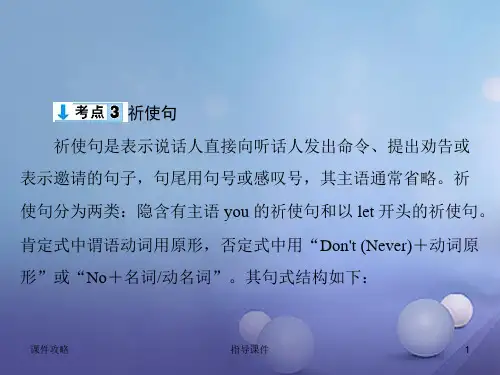
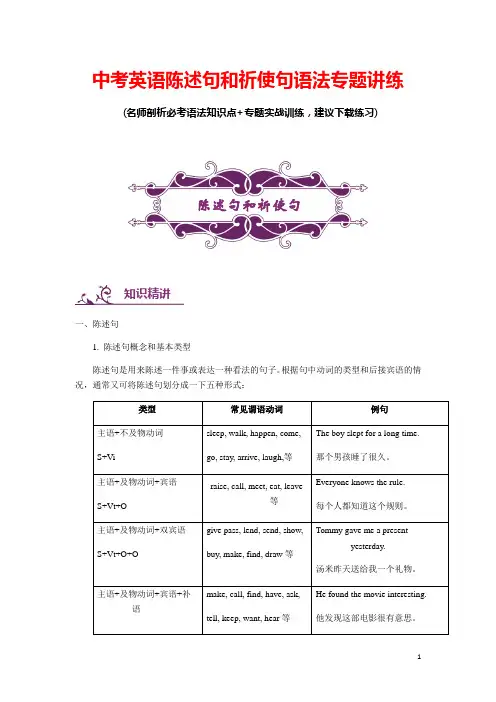
中考英语陈述句和祈使句语法专题讲练(名师剖析必考语法知识点+专题实战训练,建议下载练习)陈述句和祈使句知识精讲一、陈述句1. 陈述句概念和基本类型陈述句是用来陈述一件事或表达一种看法的句子。
根据句中动词的类型和后接宾语的情况,通常又可将陈述句划分成一下五种形式:注:S:主语;Vi:不及物动词;Vt:及物动词;P:表语;O:宾语;C:宾语补足语。
2. 陈述句的否定结构陈述句的否定一般否定在be动词,助动词或情态动词上,如:I am not a doctor but a teacher.我不是一名医生而是一个老师。
I haven’t finished my homework yet.我还没完成我的作业。
I can’t do it by myself.我不能独立完成。
在以下几种情况下,句子否定比较特殊,需要特别注意。
1). 含有have的否定句(1). have作实意动词,表“有”或“吃”时,否定在前,根据时态用don’t, doesn’t或didn’t否定,如:I didn’t have l unch today.今天我没吃午饭。
(2). have作为助动词,即在完成时中,否定直接用haven’t既可,如:I haven’t been to China yet.我还没去过中国。
2). 含有all, both, each, both…and…等的肯定句中,加not为部分否定;若表示全部否定需要把上述词变成否定形式,即no, no one, nobody, none, neither, neither…nor…等词,如:肯定:Both Tom and Jack are good students.汤姆和杰克都是好学生。
否定:Neither Tom nor Jack is good student.汤姆和杰克都不是好学生。
3). 句中含有already(已经),too(也)的肯定句加not变为否定句时,要分别把already和too变为yet和either,如:肯定:He has already finished his homework.他已经完成了他的作业。
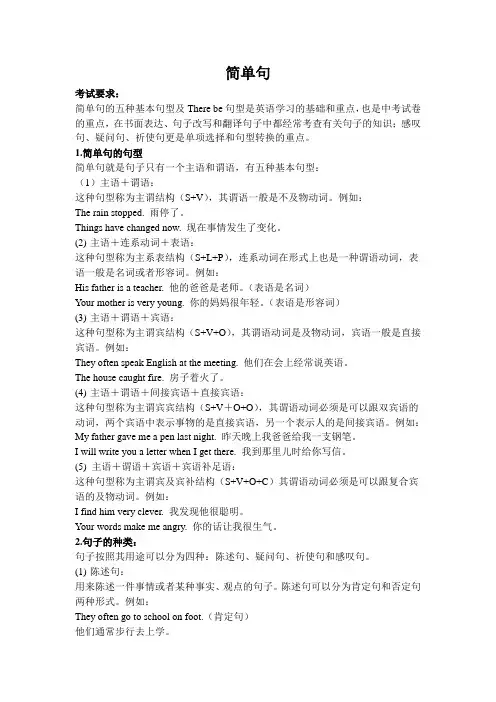
简单句考试要求:简单句的五种基本句型及There be句型是英语学习的基础和重点,也是中考试卷的重点,在书面表达、句子改写和翻译句子中都经常考查有关句子的知识;感叹句、疑问句、祈使句更是单项选择和句型转换的重点。
1.简单句的句型简单句就是句子只有一个主语和谓语,有五种基本句型:(1)主语+谓语:这种句型称为主谓结构(S+V),其谓语一般是不及物动词。
例如:The rain stopped. 雨停了。
Things have changed now. 现在事情发生了变化。
(2)主语+连系动词+表语:这种句型称为主系表结构(S+L+P),连系动词在形式上也是一种谓语动词,表语一般是名词或者形容词。
例如:His father is a teacher. 他的爸爸是老师。
(表语是名词)Your mother is very young. 你的妈妈很年轻。
(表语是形容词)(3)主语+谓语+宾语:这种句型称为主谓宾结构(S+V+O),其谓语动词是及物动词,宾语一般是直接宾语。
例如:They often speak English at the meeting. 他们在会上经常说英语。
The house caught fire. 房子着火了。
(4)主语+谓语+间接宾语+直接宾语:这种句型称为主谓宾宾结构(S+V+O+O),其谓语动词必须是可以跟双宾语的动词,两个宾语中表示事物的是直接宾语,另一个表示人的是间接宾语。
例如:My father gave me a pen last night. 昨天晚上我爸爸给我一支钢笔。
I will write you a letter when I get there. 我到那里儿时给你写信。
(5) 主语+谓语+宾语+宾语补足语:这种句型称为主谓宾及宾补结构(S+V+O+C)其谓语动词必须是可以跟复合宾语的及物动词。
例如:I find him very clever. 我发现他很聪明。
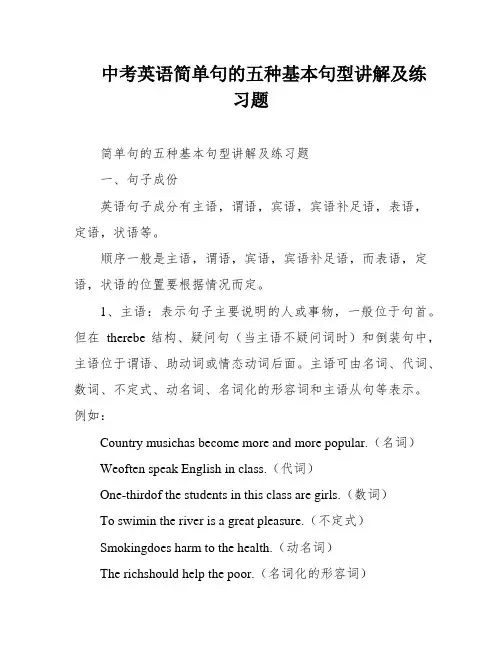
中考英语简单句的五种基本句型讲解及练习题简单句的五种基本句型讲解及练习题一、句子成份英语句子成分有主语,谓语,宾语,宾语补足语,表语,定语,状语等。
顺序一般是主语,谓语,宾语,宾语补足语,而表语,定语,状语的位置要根据情况而定。
1、主语:表示句子主要说明的人或事物,一般位于句首。
但在therebe结构、疑问句(当主语不疑问词时)和倒装句中,主语位于谓语、助动词或情态动词后面。
主语可由名词、代词、数词、不定式、动名词、名词化的形容词和主语从句等表示。
例如:Country musichas become more and more popular.(名词)Weoften speak English in class.(代词)One-thirdof the students in this class are girls.(数词)To swimin the river is a great pleasure.(不定式)Smokingdoes harm to the health.(动名词)The richshould help the poor.(名词化的形容词)When we are going to have an English testhas not been decided.(主语从句)Itis necessaryto master a foreign language.(it作形式主语,真正的主语为后面的不定式)2、谓语:谓语说明主语的动作,状态或特征。
可以有不同的时态,语态和语气。
1)简单谓语:Westudyfor the people.2)复合谓语:Ican speaka littleEnglish. Weare readingbooks. Hehas goneto Beijing..3、表语:它位于系动词(比方be)以后,申明主语身份,特性,属性或状况。
My sister isa nurse.Is ityours?(代词)The weather has turnedcold.(形容词)The speech isexciting.(分词)Three times seven istwenty one?(数词)His job isto teach English.(不定式)His hobby(快乐喜爱)isplaying football.(动名词)The rulermust bein your box.(介词短语)Time isup. The class isover.(副词)The truth isthat he has never been abroad.(表语从句)4、宾语:宾语表示动作行为的对象,跟在及物动词之后,We likeEnglish.How many dictionaries do you have? I havefive.(数词)They helpedthe oldwith their housework yesterday.(名词化描述词)It beganto rain.(不定式短语)I enjoylistening to popular music.(动名词短语)I think(that)he is fit for his office.(宾语从句)有些及物动词能够带两个宾语,每每一个指人,一个指物,指人的叫间接宾语,指物的叫间接宾语。
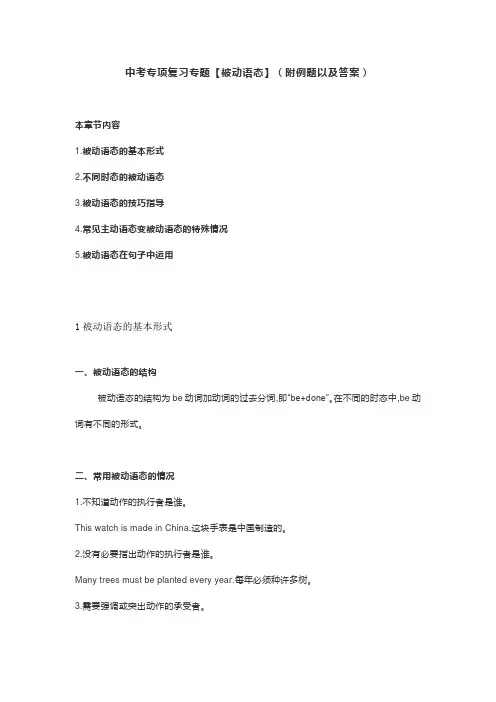
中考专项复习专题【被动语态】(附例题以及答案)本章节内容1.被动语态的基本形式2.不同时态的被动语态3.被动语态的技巧指导4.常见主动语态变被动语态的特殊情况5.被动语态在句子中运用1被动语态的基本形式一、被动语态的结构被动语态的结构为be动词加动词的过去分词,即“be+done”。
在不同的时态中,be动词有不同的形式。
二、常用被动语态的情况1.不知道动作的执行者是谁。
This watch is made in China.这块手表是中国制造的。
2.没有必要指出动作的执行者是谁。
Many trees must be planted every year.每年必须种许多树。
3.需要强调或突出动作的承受者。
Chinese is spoken by more and more people in the world.世界上越来越多的人说汉语。
(强调汉语的广泛使用)4.动作的发出者是物。
Many houses were washed away by the flood.许多房子被洪水冲走了。
2不同时态的被动语态1.时态和语态的结合是中考的必考点,尤其是一般现在时、一般过去时和一般将来时的被动语态。
2.其他时态的被动语态3.含有情态动词的被动语态结构为“情态动词+be+done”。
Your homework must be finished today.你的作业今天必须完成。
3被动语态的技巧指导(1)根据选项定考点单项填空对语态的考查均会结合时态,4个选项中一般包含两个主动语态,两个被动语态;而其对时态的考查一般不会涉及语态。
因此,如果选项中出现被动语态,即可判断此题考查被动语态,由此便可排除非被动语态的选项。
(2)根据时态选答案首先,考生需要根据关键词(时间状语)来判断时态。
对于没有关键词的试题,则要根据上下文已经给出的时态、语境理解并结合常识进行判断。
如:—Tell me one thing you’re proud of in your junior high school, Tony.—I ___ as the captain of the school football team.A. chooseB. choseC. am chosenD. was chosen方法点拨第1步:根据选项A、B为时态,C、D为被动语态可知本题考查被动语态,因此可排除A、B两项。
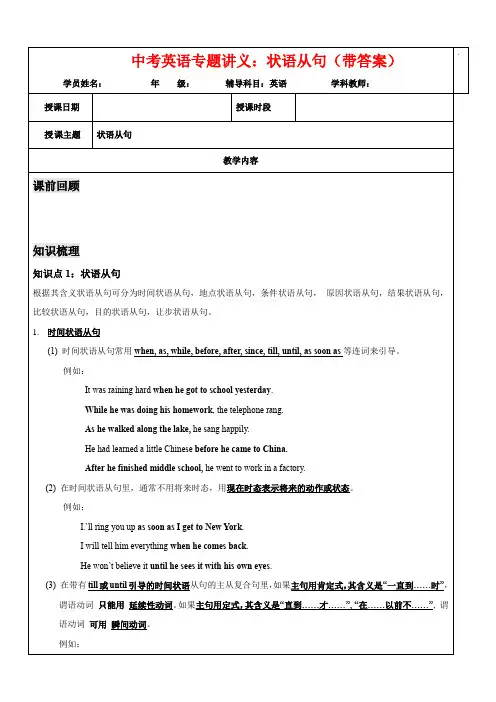
授课主题课前回顾知识梳理知识点1:状语从句根据其含义状语从句可分为时间状语从句,地点状语从句,条件状语从句,原因状语从句,结果状语从句,比较状语从句,目的状语从句,让步状语从句。
1.时间状语从句(1) 时间状语从句常用when, as, while, before, after, since, till, until, as soon as等连词来引导。
例如:It was raining hard when he got to school yesterday.While he was doing his homework, the telephone rang.As he walked along the lake, he sang happily.He had learned a little Chinese before he came to China.After he finished middle school, he went to work in a factory.(2) 在时间状语从句里,通常不用将来时态,用现在时态表示将来的动作或状态。
例如:I’ll ring you up as soon as I get to New Y ork.I will tell him everything when he comes back.He won’t believe it until he sees it with his own eyes.(3) 在带有till或until引导的时间状语从句的主从复合句里,如果主句用肯定式,其含义是“一直到……时”,谓语动词只能用延续性动词。
如果主句用定式,其含义是“直到……才……”, “在……以前不……”, 谓语动词可用瞬间动词。
例如:The young man read till the light went out.Let’s wait until the rain stops.We won’t start until Bob comes.Don’t get off until the bus stops.2. 条件状语从句(1) 条件状语从句通常由if, unless引导。
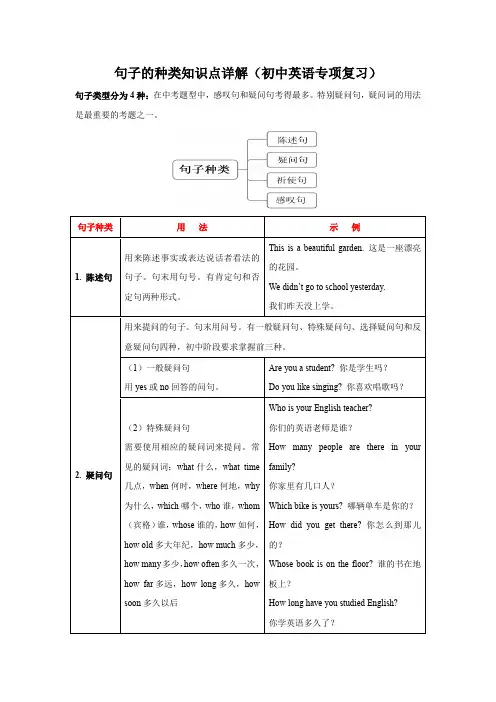
句子的种类知识点详解(初中英语专项复习)句子类型分为4种:在中考题型中,感叹句和疑问句考得最多。
特别疑问句,疑问词的用法是最重要的考题之一。
【典例】1. 他们还赢得了广东省飞镖比赛冠军。
多么棒的项目啊!They won the Championship of Guangdong Darts Match, too. ________________________ project it is!【答案】What a wonderful【解析】根据题干可知此处是一个感叹句。
中心词为可数名词project“项目”,符合结构:What+ a/an+形容词+主语+谓语。
project是以辅音音素开头,应用a;wonderful“极好的”。
故填What a wonderful。
2.. ________ it was to see the main sights of the world in the World Park!A How amazing day B. How an amazing dayC. What amazing dayD. What an amazing day【答案】D【解析】句意:在世界公园里看到世界的主要景点是多么美妙的一天啊!考查感叹句。
句子是感叹句,中心词是可数名词单数day,用感叹句结构:What a/an adj. n.+主谓。
故选D。
3.. —China won all the gold medals at the 2023 World Table Tennis Championships.—______ exciting news!A. What aB. How aC. HowD. What 【答案】D【解析】句意:——中国包揽了2023年世乒赛的所有金牌。
——多么令人兴奋的消息啊!考查感叹句,感叹句的中心词news是不可数名词,此处用“What+形容词+不可数名词”结构。
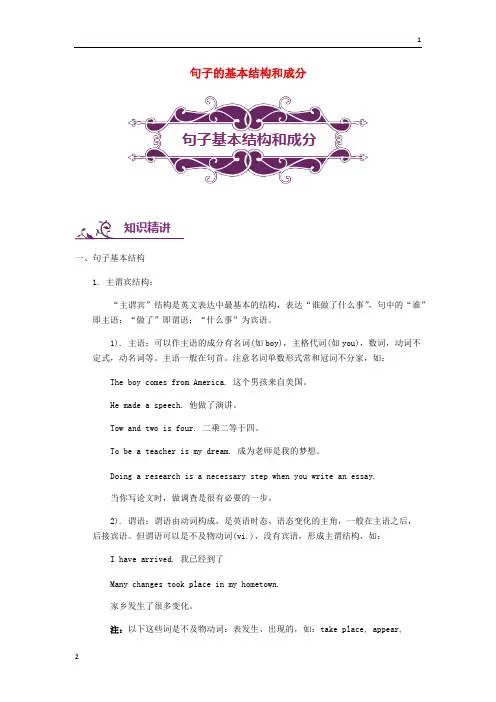
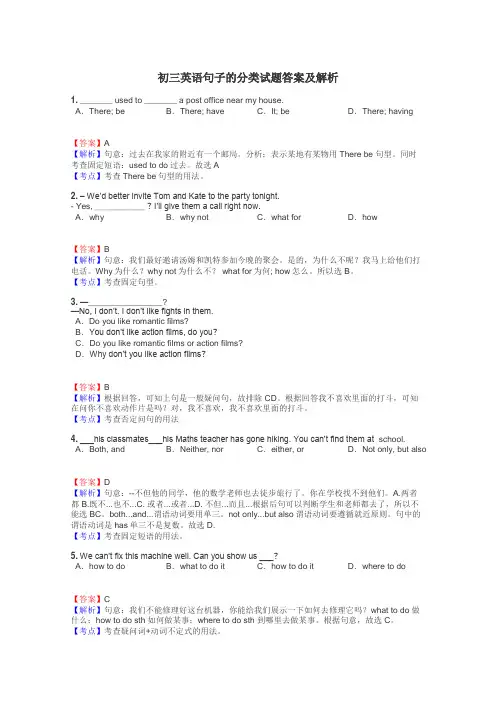
初三英语句子的分类试题答案及解析1. _______ used to _______ a post office near my house.A.There; be B.There; have C.It; be D.There; having【答案】A【解析】句意:过去在我家的附近有一个邮局。
分析:表示某地有某物用There be 句型。
同时考查固定短语:used to do过去。
故选A【考点】考查There be句型的用法。
2.–We’d better invite Tom and Kate to the party tonight.- Yes, ______? I’ll give them a call right now.A.why B.why not C.what for D.how【答案】B【解析】句意:我们最好邀请汤姆和凯特参加今晚的聚会。
是的,为什么不呢?我马上给他们打电话。
Why为什么?why not为什么不? what for为何; how怎么。
所以选 B。
【考点】考查固定句型。
3.—________________?—No, I don’t. I don’t like fights in them.A.Do you like romantic films?B.You don’t like action films, do you?C.Do you like romantic films or action films?D.Why don’t you like action films?【答案】B【解析】根据回答,可知上句是一般疑问句,故排除CD。
根据回答我不喜欢里面的打斗,可知在问你不喜欢动作片是吗?对,我不喜欢,我不喜欢里面的打斗。
【考点】考查否定问句的用法4.___his classmates___his Maths teacher has gone hiking. You can’t find them at school. A.Both, and B.Neither, nor C.either, or D.Not only, but also【答案】D【解析】句意:--不但他的同学,他的数学老师也去徒步旅行了。
【通用版】中考英语专题讲练含答案现在进行时一、现在进行时现在进行时表示正在进行的动作或存在的状态。
现在进行时表示动作发生的时间是“现在”,动作目前的状态是“正在进行中”。
二、句子结构主语+is /am/are +doing (现在分词)三、基本用法四、时间状语1. now, right now2. at this/the moment3. Look! Listen! Be quite!4. these days五、动词现在分词规则变化六、相关句型:三点剖析一、考点:现在进行时的基本用法及时间状语、动词现在分词的变化规则。
二、易错点:1. 现在进行时表示将来现在进行时除表示正在进行的动作之外还可以表示即将发生的动作或在最后按计划或安排打算要进行的动作,这时一般带一个表示将来时间的状语,但有时上下文较明确的情况下无需指出时间。
能用现在进行时表示将来时的动词仅限于少量主要表示方位移动的动词。
如:come, go, leave, die, start, arrive, get, stay, travel, do, work, give, reach, return, play, have, meet, take, get to, see off 等。
例:They are playing some folk music next.他们下面将演奏一些民间乐曲。
We are having an English party tonight.今晚我们要开英语晚会。
A foreign teacher is arriving at 6:00. Is anyone meeting him at the airport?外教六点到,有人去接他么?2. 某些表示感觉或状态的动词,如 love, like, prefer, hate, see, know等一般不用现在进行时。
例:Lucy prefers art to science.露西比起科学来更喜欢艺术。
2020 年中考英语总复习基础语法专题复习讲义目录:1.专题七动词的种类2.专题八动词的时态3.专题九被动语态专题七动词的种类学前自测(发现考点)( )1. Lucy and her friend will at the airport in half an hour. They are going to Taiwan.A. playB. comeC. leaveD. meet( )2. —May I play computer games now, Mum?—No, you __ . You haven't finished your homework yet.A. don'tB. needn'tC. can'tD. may not( )3. —Shall we take a bus to the library?—It ’ s not far. I think we __t_ake a bus. Let ’ s walk there.A. mustn'tB. couldn'tC. can'tD. needn't( )4. —How much did this dictionary ___ you, Sally? —I got it for 90 yuan.A. useB. costC. takeD. spend( )5. It is very hot here. Why not your coat?A. to take offB. put offC. take offD. puton( )6. The hotel is not far, so you take a bus.A. may notB. needn'tC. can'tD.mustn't( )7. The price of vegetables ___ so quickly these days.A. risesB.affordC.improvesD.raise( )8. My computer doesn t work. There be something wrong with it, but I'm not sure.A. couldB. mustC. mayD. need( )9. Hello! I'm very glad to see you. When you here?A. are; arrivingB. did; arriveC. have; arrivedD. will;arrive ( )10. —Ann, are you hurrying out?—I go now or I'll be late for the meeting.A. mustB. canC. needn'tD. don't have to常考考点知识清单(研习考点) 考点一行为动词/实义动词行为动词/实义动词可分为及物动词和不及物动词,可接宾语的是及物动词,不可以接宾语的是不及物动词。
简单句考试要求:简单句的五种基本句型及There be句型是英语学习的基础和重点,也是中考试卷的重点,在书面表达、句子改写和翻译句子中都经常考查有关句子的知识;感叹句、疑问句、祈使句更是单项选择和句型转换的重点。
1.简单句的句型简单句就是句子只有一个主语和谓语,有五种基本句型:(1)主语+谓语:这种句型称为主谓结构(S+V),其谓语一般是不及物动词。
例如:The rain stopped. 雨停了。
Things have changed now. 现在事情发生了变化。
(2)主语+连系动词+表语:这种句型称为主系表结构(S+L+P),连系动词在形式上也是一种谓语动词,表语一般是名词或者形容词。
例如:His father is a teacher. 他的爸爸是老师。
(表语是名词)Your mother is very young. 你的妈妈很年轻。
(表语是形容词)(3)主语+谓语+宾语:这种句型称为主谓宾结构(S+V+O),其谓语动词是及物动词,宾语一般是直接宾语。
例如:They often speak English at the meeting. 他们在会上经常说英语。
The house caught fire. 房子着火了。
(4)主语+谓语+间接宾语+直接宾语:这种句型称为主谓宾宾结构(S+V+O+O),其谓语动词必须是可以跟双宾语的动词,两个宾语中表示事物的是直接宾语,另一个表示人的是间接宾语。
例如:My father gave me a pen last night. 昨天晚上我爸爸给我一支钢笔。
I will write you a letter when I get there. 我到那里儿时给你写信。
(5) 主语+谓语+宾语+宾语补足语:这种句型称为主谓宾及宾补结构(S+V+O+C)其谓语动词必须是可以跟复合宾语的及物动词。
例如:I find him very clever. 我发现他很聪明。
一般现在时知识精讲一般现在时一、一般现在时表示通常性、规律性、习惯性、真理性的状态或者动作有时间规律发生的事件的一种时间状态。
二、句子结构主语(第一、二人称、第三人称复数)+do (动词原形)主语(第三人称单数)+does (动词三单形式)主语+am/is/are三、基本用法用法示例表示经常性或习惯性的动作We get up at six every morning.我们每天早上六点钟起床。
表示现在的状态、能力、性格Mr. Wang writes good English but he doesn’t speak well.王先生的英文写得很好但他说不好。
表示格言或警句Pride goes before a fall.四、时间状语1.2.every/once + 名词:every day/ week/ year, once a week/month …3.表示时间的短语:twice a day, on weekends, on Mondays…五、一般现在时三单数动词的变化规律六、相关句式三点剖析一、考点:时态是英语学习中的核心内容之一,是英语学习的基础。
自然,时态考查是各种英语考试尤其是中考考时的座上宾。
动作发生的时间决定时态,时态决定动词的形式,而考卷中的时态题通常没有给出明确的时间标志词,考试需领悟所提供的语境来做出判断。
只有推断出动作发生的正确的时间,才可能正确答题,这就要求考生在熟练掌握时态结构、用法并牢记常用的时间状语的基础上,要充分利用上下文中隐含的信息来捕捉时间,找准答题的突破口。
二、重难点:一般现在时在考试中的重难点是:句子结构、基本用法、标志时间状语、动词的三单变化规律及相关句式的变化。
三、补充点:1.表示按计划或安排好的,或将要发生的动作,可用一般现在时表将来。
但只限于start, begin, leave, go, come, arrive, return, take place 等。
中考英语专题讲义:句子类型(带答案)学科老师辅导讲义学员姓名:年级:辅导科目:英语学科教师:授课日期授课时段授课主题句子类型教学内容课前回顾:1.检查作业,错题讲解(错题本)2.复习上节课知识点(笔记本)3. 词汇短语默写知识梳理知识点1:陈述句1. 陈述句:陈述句是用来陈述一个事实或表达说话人看法(包括肯定和否定)的句子。
通常用降调,句末用句号“.”Tom has a new car.The flower isn’t beautiful.2. 陈述句否定式的构成(1) 如果肯定陈述句的谓语部分含有助动词、情态动词或连系动词b e,则只需在这些动词后加not即可构成否定式。
He is playing the guitar.(肯定)He is not playing the guitar.(否定)We can get there before dark.(肯定)We can’t get thee before dark.(否定)(2) 如果陈述句的谓语动词是实义动词,而其中又没有情态动词或助动词时,则需根据人称和时态在该实义动词前加don’t, doesn’t或didn’t。
同时把该实义动词变为原形。
He plays the violin well.(肯定)He doesn’t play the violin well.(否定)She won the game.(肯定)She didn’t win the ga me.(否定) (3) 如果句子是there be结构或谓语动词是have(有),除了be和have之后加not之外,句中如果有some要变为any。
例如:There is some water in the cup. →There is not any water in the cup.He has some books. →He has not any books.(4) 除not以外,否定词no, never, nothing, nobody, few等也可构成否定句。
例如:There is something wrong with his bike. →There is nothing wrong with his bike.I have seen the film. →I have never seen the film.知识点2:祈使句祈使句是用来表示命令、请求、建议、号召等的句子,谓语动词用原形,句末用感叹号“!”或句号“.”。
朗读时一般用降调。
1. 肯定的祈使句:(1)祈使句主语是you时,you常省略,但如果要特别强调对方或表达某种强烈的情绪时可以有主语或称呼语。
Be quiet.You be quiet! (2)“Do+祈使句”表示一种强烈的感情或请求,do起强调作用。
Do come back at once!Do be careful. (3)please用在祈使句中可以表示一种客气的语气,但please用在句末时,必须用逗号与其余部分分开。
Open the window, please. (4)Let引导祈使句时,后面需跟上人称代词或称呼语,人称代词一般只用第一、第三人称。
Let Jack wait a minute.Let’s go to school.(5)在祈使句中,Let’s和Let us是有区别的。
Let’s包括说话者,而Let us不包括听话者在内。
这点从反意疑问句时可明显看出。
Let’s go skating, shall we?(表示内部的建议) Let us try again, will you?(表示向别人发出请求)2. 否定祈使句通常以Don’t或Never开头。
其结构通常是:“Don’t(Never)+动词原形+其他成分” 例如:Don’t do that again!Never leave today’s work for tomorrow!Don’t be late next time!知识点3:疑问句1. 一般疑问句:(1)一般疑问句的肯定形式一般疑问句一般是指以助动词、情态动词、be动词或have(有)开始,通常要求以yes,或no来回答的疑问句,一般疑问句读时通常用升调。
Do you know Mr. Smith?Can you swim?(2)一般疑问句的否定结构①在一般疑问句的否定结构中,把副词not放在一般疑问句的主语之后。
但如果用not的简略形式-n’t,则须将-n’t与一般疑问句句首的be, have,助动词或情态动词写在一起。
在实际运用中,一般都采用简略式。
Are you not a football fan?Aren’t you a football fan?Will she not like it?Won’t she like it?②与汉语不同的是,英语一般疑问句否定结构的答语是否定还是肯定,全由答语的否定或肯定来决定。
若答语是肯定的,则用yes加肯定结构;若答语是否定的,则用no加否定结构。
Aren’t you a football fan? 你不是足球迷吗? Yes, I am. No, I am not.Won’t she like it?Yes, she will.No, she won’t.2. 选择疑问句:选择疑问句是说话者提出两种或两种以上的不同情况,让对方选择回答的疑问句。
其结构是“疑问句+选择部分”。
选择部分由or连接,or前面的部分读升调,or后面的部分读降调。
选择疑问句不能用yes或no回答,而必须具体的选择答复。
Is your bag yellow or black? It’s black.。
Would you like some tea or coffee? Either will do.。
Which do you like bet ter, singing or dancing? I like dancing better.3. 特殊疑问句特殊疑问句由“疑问代词或疑问副词+一般疑问句”构成,句子一般用倒装语序,但如果主语是疑问代词或由疑问代词修饰时,用陈述句的语序。
特殊疑问句不能用yes或no回答,读时用降调。
例如:Who is on duty today? How long have you been in Beijing? What time do you get up every morning? What must I do now? 常用的特殊疑问句询问内容疑问词或句型例句回答职业,身份what What is your father? He is a doctor.姓名或关系who Who is that boy? He is Jack.He is my brother相貌特征what…lke?What is she like?What does she look like?She is beautiful.目的what…for? What did they come here for? To attend a meeting.原因why Why did they come here? Because they have a meeting to attend.天气 howwhat…like?How is the weather toay?What is the weater like today?It’s fine.颜色what color…?What dolor is her skirt? It’s red.服装尺寸what size What size does he wear? He wears 40. 几点钟what time What time is it? It’s 7:30.星期几what day What day is today? It’s Tuesd y.几号,日期what is te date…?What is the date today? It’s May 2.年龄(多大)how old How old is he? He is 38.持续多长时间(多久)how long How long have you been here? For five months. 长度(多长)how long How long is the bridge? It’s 500 metres.距离(多远)how far How far ist from here to the zoo?It’s 6 kilometres.频度(多经常)how often How often do you come back? Once a week. 时间经过(多快)how soon How soon will she arrive? In an week.数量(多少)how many(可数名词)how much(不可数名词)How many jackets doyou have?How much cofee do you want?Three.Two cups.价格how much How much is it?How much does it cost?Five dollars.高度(多高)how tall(人,树)how high(山,建筑物)How tall is she?How high is the tower?She’s 1.73 metres.It’s 450 metres.巩固练习I. 单项填空1. ---Excuse me, _______ is the nearest bookshop?---Go down the street and turn left at the second corner.A. howB. whatC. whereD. who2. ---______ is it from our school to the Bell Tower?---About half an hour’s bus ride. Shall we go and visit it?A. How longB. How oftenC. How farD. How much3. ---Linda had nothing for breakfast this morning, _______?---No. She got up too late.A. had sheB. hadn’t sheC. did sheD. didn’t she4. ---The room is so dirty. ______ we clean it?---Of course.A. WillB. WouldC. DoD. Shall5. ---__________, sir?---Size 41, I think A. What size do you need B. What can I do for youC. How do you like this shirtD. What’s the matter with you6. ---_______ good weather! Why not go out for a walk?A. WhatB. HowC. What aD. How a7. ---It’s a nice car. ______ have you been in it?---Ju st to Shanghai.A. How muchB. How longC. How soonD. How far8. ---_______ to the United States?---No, never, but I went to Canada a few years ago.A. Have you beenB. Have you goneC. Did you goD. Will you go9. ---_______ were you away from school last year?---About two weeks.A. How oftenB. How soonC. How longD. When10. ---______ do you want?---I want a CD of popular songs.A. Whi ch CDB. How many CDsC. What CDD. How much11. _______ is your mother, a teacher or a doctor?A. WhatB. WhichC. WhoD. whose12. ---______ is your mother today, Jim?---She is much better.A. HowB. WhatC. WhereD. How old13. ---______he ______ at this school last term?---Yes, I think so.A. Did…studyB. Does…studyC. Was…studyD. Did…studied14. ---_______ did you begin to learn English?---Three years ago.A. WhenB. WhyC. WhereD. What15. ---________ do you write to your pen-friend?---Once a week.A. How longB. How soonC. How farD. How often16. _______ nice flowers! Where did you pick them?A. HowB. WhatC. What aD. How a17. The sick man’s allowed to take a walk in the garden every day, _______?A. is heB. isn’t heC. has heD. hasn’t he18. ______ cross the road before the traffic lights turn green.A. NotB. Won’tC. Don’tD. Doesn’t19. He found nothing in the room, _________?A. doesn’t heB. does heC. didn’t heD. did he20. Yo u haven’t changed your mind, ________?A. do youB. are youC. have youD. did you1.C2.C3.C4.D5.A6.A7.D8.A9.C 10.C 11.A 12.A 13.A 14.A 15.D 16.B 17.B 18.C 19.D 20.CII. 句型转换(按要求改写下列句子)1. Bruce bought a dictionary yesterday. (改为否定句)Bruce ________ ________ a dictionary yesterday.2. Mr. Smith does morning exercises every day. (改为一般疑问句)________ Mr. Smith ______ morning exercises every day?3. Allan will go back to England by plane next month. (就划线部分提问)________ _______ Allan go back to England next month?4. There are some apples on the table. (改为否定句)There _______ _______ apples on the table.5. When she sees you, she will tell you the news(就划线部分提问)_______ ______ she tell you the news?6. Uncle Wang likes making things. (改写为否定句)Uncle Wang _______ _______ making things.7. Ann returned the book to the library yesterday. (改为一般疑问句)________ Ann _______ the book to the library yesterday?8. Our city is very bea utiful. (改为感叹句)_______ _______ our city is!9. He has worked in this school for five years. (就划线部分提问)_______ _______ has he worked in this school?10. Both of them are my best friends. (改为否定句)_______ of them _______ my best friend.11. They are happy to see each other. (改为感叹句)_______ ______ they are to see each other!12. The exam begins at nine. (改为一般疑问句)________ the exam _______ at nine?13. He was playing basketball at four yesterday afternoon. (就划线部分提问)______ ______ he ______ at four yesterday afternoon?14. He had nothing for breakfast. (改为反意疑问句)He had nothing for breakfast ______ _______?15. She doesn’t think I can surf on the Internet. (改反意疑问句)She doesn’t think I can surf on the Interne t, _______ _______?16. He’s put the tree in the hole? (改为一般疑问句)二、英语书面表达专项训练2.中国传统文化源远流长,代代相传。